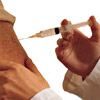Safety of HPV4 vaccine confirmed for adolescents and young women
A study of almost 200,000 young females who received the quadrivalent human papilloma virus (HPV4) vaccine found that immunisation was associated only with same-day syncope (fainting) and skin infections in the two weeks after vaccination. These findings support the general safety of routine vaccination with HPV4 in a clinical care setting to prevent cervical and other genital and reproductive cancers.
The association between HPV4 and syncope was not unexpected, the researchers noted, because injections in general are known to have a correlation to fainting, particularly in the study’s age group. The review of skin-infection diagnoses suggested that some may have been local injection-site reactions, although there was insufficient detail to exclude acute infections.
The study appears in the current online issue of Archives of Pediatrics & Adolescent Medicine.
“Taking into account all the analyses, sub analyses and relevant medical record reviews, an independent safety committee noted that there may be an association between HPV4 vaccination and same-day syncope, as well as skin infections during the two weeks after immunisation,” said lead author Nicola Klein, MD, PhD, co-director and research scientist at the Kaiser Permanente Vaccine Study Center in Oakland, Calif.
Dr. Klein outlined the study’s strengths — a large, ethnically diverse population who received a total of nearly 350,000 HPV4 doses; an integrated health care delivery system that assured complete or near-complete medical information; and a pre-specified, validated, clinically meaningful system to categorise all outcomes. However, she noted that ongoing monitoring of spontaneous reports and other sources such as the Vaccine Safety Datalink will further contribute to HPV4’s safety profile.
Human papillomavirus (HPV) is a family of small DNA viruses that are associated with the most commonly detected sexually transmitted infection in women. While most HPV infections cause no symptoms and are self-limited, persistent genital HPV infection can lead to cervical cancer. HPV is estimated to cause over half a million new cancers every year, most of which affect women in developing countries.
The Food and Drug Administration approved the quadrivalent HPV vaccine in 2006 for females between the ages of 9 to 26 for prevention of a range of diseases attributed to HPV. More recently, HPV4 was approved for the same age group for the prevention of vaginal and vulvar cancer, for males between the ages of 9 to 26 years for the prevention of genital warts, and in both males and females for the prevention of anal intraepithelial neoplasia and cancer.
The study was conducted within the integrated health care delivery systems of Northern and Southern California Kaiser Permanente, which each have more than 3 million member’s representative of the regions’ populations, and included 189,629 females who received one or more doses of HPV4 between August 2006 and March 2008.
The design of the study compared the risk of emergency department visits and hospitalisations during post-vaccination intervals of 1–60 days, 1–14 days and day 0 (day of vaccination) with control intervals ranging from 60 days for those who received one dose of HPV4 to 180 days for those who received three doses.
“That this study detected two potentially expected outcomes provides reasonable reassurance that it was a valid approach to uncovering HPV4-associated safety signals,” Dr. Klein said. “The findings substantiate the overall safety of the HPV4 vaccine in women and girls following routine administration.”
(Source: Kaiser Permanente: Archives of Pediatrics & Adolescent Medicine)
More information
 | For more information on immunisation, including the childhood immunisation scedule, types of vaccines, preconception screening, as well as some useful videos, see Immunisation. |
Dates
Created by:

 Login
Login














